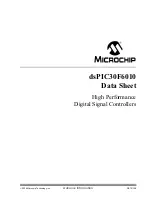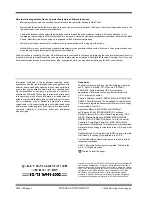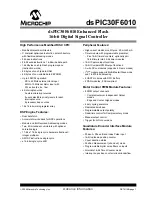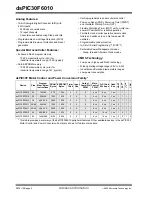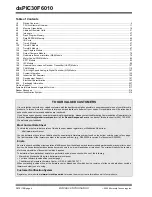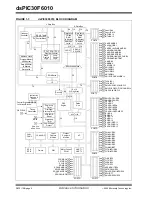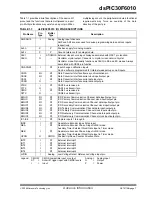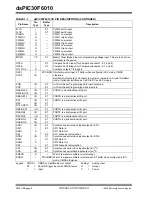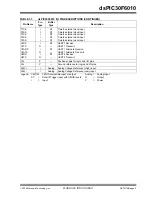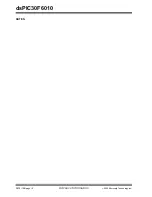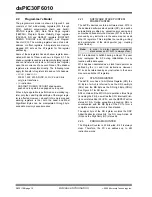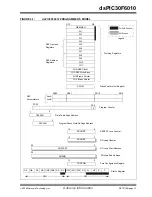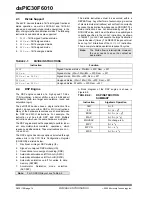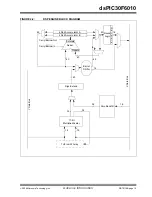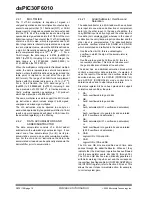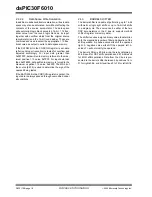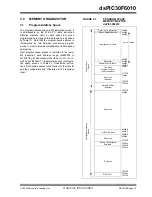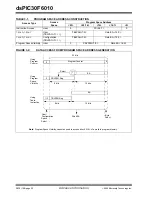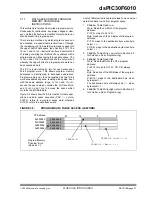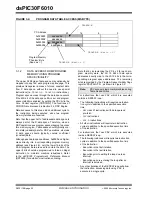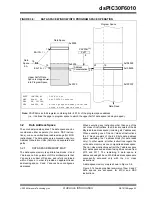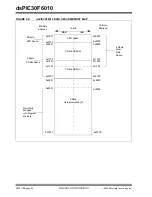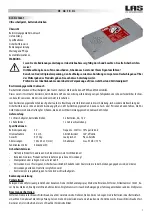
2004 Microchip Technology Inc.
Advance Information
DS70119B-page 11
dsPIC30F6010
2.0
CPU ARCHITECTURE
OVERVIEW
This document provides a summary of the
dsPIC30F6010 CPU and peripheral function. For a
complete description of this functionality, please refer
to the
dsPIC30F Family Reference Manual
(DS70046).
2.1
Core Overview
The core has a 24-bit instruction word. The Program
Counter (PC) is 23 bits wide with the Least Significant
(LS) bit always clear (see Section 3.1), and the Most
Significant (MS) bit is ignored during normal program
execution, except for certain specialized instructions.
Thus, the PC can address up to 4M instruction words
of user program space. An instruction pre-fetch mech-
anism is used to help maintain throughput. Program
loop constructs, free from loop count management
overhead, are supported using the
DO
and
REPEAT
instructions, both of which are interruptible at any point.
The working register array consists of 16x16-bit regis-
ters, each of which can act as data, address or offset
registers. One working register (W15) operates as a
software stack pointer for interrupts and calls.
The data space is 64 Kbytes (32K words) and is split
into two blocks, referred to as X and Y data memory.
Each block has its own independent Address Genera-
tion Unit (AGU). Most instructions operate solely
through the X memory AGU, which provides the
appearance of a single unified data space. The
Multiply-Accumulate (
MAC
) class of dual source DSP
instructions operate through both the X and Y AGUs,
splitting the data address space into two parts (see
Section 3.2). The X and Y data space boundary is
device specific and cannot be altered by the user. Each
data word consists of 2 bytes, and most instructions
can address data either as words or bytes.
There are two methods of accessing data stored in
program memory:
• The upper 32 Kbytes of data space memory can
be mapped into the lower half (user space) of pro-
gram space at any 16K program word boundary,
defined by the 8-bit Program Space Visibility Page
(PSVPAG) register. This lets any instruction
access program space as if it were data space,
with a limitation that the access requires an addi-
tional cycle. Moreover, only the lower 16 bits of
each instruction word can be accessed using this
method.
• Linear indirect access of 32K word pages within
program space is also possible using any working
register, via table read and write instructions.
Table read and write instructions can be used to
access all 24 bits of an instruction word.
Overhead-free circular buffers (modulo addressing) are
supported in both X and Y address spaces. This is pri-
marily intended to remove the loop overhead for DSP
algorithms.
The X AGU also supports bit-reversed addressing on
destination effective addresses, to greatly simplify input
or output data reordering for radix-2 FFT algorithms.
Refer to Section 4.0 for details on modulo and
bit-reversed addressing.
The core supports Inherent (no operand), Relative, Lit-
eral, Memory Direct, Register Direct, Register Indirect,
Register Offset and Literal Offset Addressing modes.
Instructions are associated with predefined Addressing
modes, depending upon their functional requirements.
For most instructions, the core is capable of executing
a data (or program data) memory read, a working reg-
ister (data) read, a data memory write and a program
(instruction) memory read per instruction cycle. As a
result, 3-operand instructions are supported, allowing
C = A+B operations to be executed in a single cycle.
A DSP engine has been included to significantly
enhance the core arithmetic capability and throughput.
It features a high speed 17-bit by 17-bit multiplier, a
40-bit ALU, two 40-bit saturating accumulators and a
40-bit bi-directional barrel shifter. Data in the accumu-
lator or any working register can be shifted up to 16 bits
right or 16 bits left in a single cycle. The DSP instruc-
tions operate seamlessly with all other instructions and
have been designed for optimal real-time performance.
The
MAC
class of instructions can concurrently fetch
two data operands from memory, while multiplying two
W registers. To enable this concurrent fetching of data
operands, the data space has been split for these
instructions and linear for all others. This has been
achieved in a transparent and flexible manner, by ded-
icating certain working registers to each address space
for the
MAC
class of instructions.
The core does not support a multi-stage instruction
pipeline. However, a single stage instruction pre-fetch
mechanism is used, which accesses and partially
decodes instructions a cycle ahead of execution, in
order to maximize available execution time. Most
instructions execute in a single cycle, with certain
exceptions.
The core features a vectored exception processing
structure for traps and interrupts, with 62 independent
vectors. The exceptions consist of up to 8 traps (of
which 4 are reserved) and 54 interrupts. Each interrupt
is prioritized based on a user assigned priority between
1 and 7 (1 being the lowest priority and 7 being the
highest) in conjunction with a predetermined ‘natural
order’. Traps have fixed priorities, ranging from 8 to 15.
Summary of Contents for dsPIC30F6010
Page 12: ...dsPIC30F6010 DS70119B page 10 Advance Information 2004 Microchip Technology Inc NOTES...
Page 32: ...dsPIC30F6010 DS70119B page 30 Advance Information 2004 Microchip Technology Inc NOTES...
Page 38: ...dsPIC30F6010 DS70119B page 36 Advance Information 2004 Microchip Technology Inc NOTES...
Page 50: ...dsPIC30F6010 DS70119B page 48 Advance Information 2004 Microchip Technology Inc NOTES...
Page 68: ...dsPIC30F6010 DS70119B page 66 Advance Information 2004 Microchip Technology Inc NOTES...
Page 72: ...dsPIC30F6010 DS70119B page 70 Advance Information 2004 Microchip Technology Inc NOTES...
Page 76: ...dsPIC30F6010 DS70119B page 74 Advance Information 2004 Microchip Technology Inc NOTES...
Page 86: ...dsPIC30F6010 DS70119B page 84 Advance Information 2004 Microchip Technology Inc NOTES...
Page 108: ...dsPIC30F6010 DS70119B page 106 Advance Information 2004 Microchip Technology Inc NOTES...
Page 116: ...dsPIC30F6010 DS70119B page 114 Advance Information 2004 Microchip Technology Inc NOTES...
Page 128: ...dsPIC30F6010 DS70119B page 126 Advance Information 2004 Microchip Technology Inc NOTES...
Page 150: ...dsPIC30F6010 DS70119B page 148 Advance Information 2004 Microchip Technology Inc NOTES...
Page 164: ...dsPIC30F6010 DS70119B page 162 Advance Information 2004 Microchip Technology Inc NOTES...
Page 208: ...dsPIC30F6010 DS70119B page 206 Advance Information 2004 Microchip Technology Inc NOTES...
Page 220: ...dsPIC30F6010 DS70119B page 220 Advance Information 2004 Microchip Technology Inc NOTES...
Page 221: ...2004 Microchip Technology Inc Advance Information DS70119B page 221 dsPIC30F6010 NOTES...

